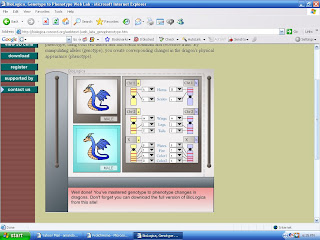
LAB TWO: Genetics
Dragon/Punnett Square
Below are pictures of the two lab projects pertaining to genetics. These lab projects toured through different examples of the process of genetics. The little dragon went through a process of changes in his chromosome types, but with skill became genetically identical to his father. The little fly was brought through a whirlwind, while piecing together the Punnett Square. Both of the labs descriptively showed the inheritance of genes. While describing each project, I will give a brief description of several genetic terminology. To start off, the genotype is the gene of the specific organism/individual. While the phenotype is the physical appearance. An allele is when the gene is on the same position with the same trait on a chromosome. Typically an allele is described using a letter. Gene inheritance is a significant piece of information, because it obviously is passed on from generation to become who we are. Parents make wonderful offspring's. Learning about genetics is important, especially when it comes to family history of diseases. Parents can be carriers for these disorders, the popular way for checking is by using a Family Pedigree chart. This gives a clear example if the disease will be passed on to the offspring.
Dragons. This lab showed the process of changing the genotypes (genes of the dragon) and phenotype(the physical appearance: sweeping tail, flapping wings, horns, feet). Genes are known as traits inherited from generation to generation. Labeled to the right of the screen were the different chromosomes of the dragon, the purpose was to change the Allele's (the letters/gene with the same position and trait on a chromosome). Dominant traits are classified in capital letter while recessive traits are in lowercase letters. There are three different possible ways to describe the fertilization. 1. Homozygous dominant genotype. The dragon has the same tail alleles: TT. 2. Homozygous recessive genotype. The dragon had several examples of the same recessive allele: ss(scales), ff(fire) aa(color) pp(plates) ww(wings). 3. Heterozygous genotype. The dragon had two alleles: Hh(hair) Bb (color). Many of the genotypes are that of a homozygous recessive gene.
 Flies. The "father of modern genetics" is given to a scientist known as Gregor Johann Mendel, who researched mainly plants. Many genetic researchers find the Fruit fly to be a popu
Flies. The "father of modern genetics" is given to a scientist known as Gregor Johann Mendel, who researched mainly plants. Many genetic researchers find the Fruit fly to be a popu lar modular organism, as shown to the right (wiki). During the lab portion of the Punnett Square, it shows how this process predicts the offspring of genes. The mother and father were both heterozygous (Ll). The offspring resulted in a dominant homozygous trait(LL long-winged) and a recessive trait (ll short-winged). The other two were that of the parents: heterozygous(Ll long-winged). This project proves to show how traits pass on from each generation.
lar modular organism, as shown to the right (wiki). During the lab portion of the Punnett Square, it shows how this process predicts the offspring of genes. The mother and father were both heterozygous (Ll). The offspring resulted in a dominant homozygous trait(LL long-winged) and a recessive trait (ll short-winged). The other two were that of the parents: heterozygous(Ll long-winged). This project proves to show how traits pass on from each generation.Terminology
Genotype: Represents the genes carried by the individual/organism. Examples (ff fire) (ww wings) (LL long wing) (ll short wing)
Phenotype: The physical appearance of the individual/organism. Examples from the dragon: horns, fire, legs, tail, and wings. The fly phenotypes were: long/short wing
Allele: Is a form of a gene. It represents one or more DNA sequences( gene positioned the same on a chromosome producing the same phenotype trait). Classified as a dominant or recessive allele.
Cross: Two different crosses were discussed in this chapter: one-trait and two-trait. An example of the One-trait is the fly punnett square. Finding the chances of the offspring having a long-wing or short-wing. Parents often get curious what color eyes/how tall their child will be. The Two-Traitis the relation of meiosis formed by gametes. It is a combination of genes. Examples in the book were the phenotypes: widows peak and short fingers. This is done using a Dihybrid cross- to find the possibilities of genotype and phenotype.
The dominant and recessive traits are discussed under both of the lab pictures.
Experimenting with these labs, marked the interest in the process of inheriting different genes. The dragon turned out identical to its father, after changing the characteristic traits of the little dragon to match the genes of the father. The fly matched well, with the simple cross section between two heterozygous parents. Passed on from generation, offspring's typically look like their parents/grandparents/siblings, some have a dominant trait while others inherit a recessive trait. Genetic inheritance can be a fun way to experiment, but also can be serious when it comes to the possibility of inheriting a family disease.
Works Cited:
Fly lab
quote/picture of fly
Dragon lab
picture is of my sister and her son: genetic generation :)


No comments:
Post a Comment